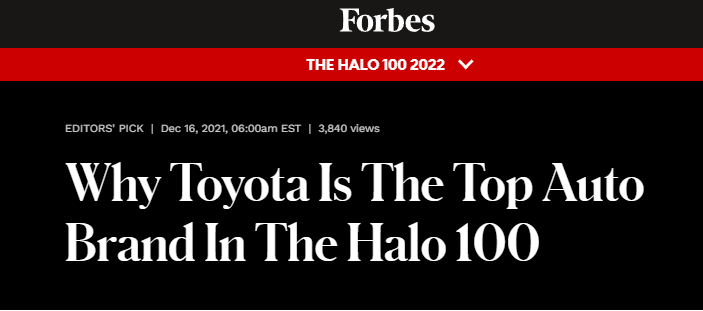HundredX Data Reveals Why Toyota is Loved by Consumers

This article, written by Marty Sant of Forbes, is a partial reprint of an article that appears as part of the 2021 Forbes Halo 100 list powered by Hundred X.
Forbes has partnered with HundredX to provide analytics and insights for the Halo 100 list.
People love their cars. While Toyota ranks No. 6 on the 2022 Forbes Halo 100 list, powered by HundredX, it’s not the only auto brand to make the top 100. Coming in at No. 10 is Subaru, followed by Tesla at No. 51 and Mazda at No. 100. When adjusting the ranking based on responses by people of color, Toyota falls to No. 13, Subaru falls to No. 70, Tesla jumps to No. 44 and Mazda falls to No. 106.
According to HundredX’s survey respondents, key strengths for Toyota were quality and reliability as well as performance. For the latter, the auto brand scored 28% higher than its competitors and scored 12% higher than the industry average when it came to performance. When asked whether they would buy another Toyota, 80% of customers said they would.
When comparing Toyota to other auto brands, the company outperformed dozens of other car brands, edging ahead of Ford to be the most relevant brand and being bested only by Lexus—another Toyota subsidiary—in terms of its Net Promoter Score®.
In terms of demographics, Toyota outperformed other car brands in every age group other than people in their 30s, according to HundredX. The car company also did well with consumers of color. While 97% of all consumers said Toyota addresses consumers needs, so did 88% African American and Black respondents, 94% of Hispanic and Latino respondents and 97% of Asian respondents. (For reference, around 40% of the 110,000 consumers surveyed by HundredX identified as people of color.)
Also key for Toyota customers is sustainability, with 25% of respondents listing it as a key factor. (Treatment of customers was even more important, with 35% of respondents mentioned that as one of the top brand values.)
To more about Toyota and other brands on the Forbes Halo 100, Click Here
Learn more about HundredX and our solutions by requesting a demo.
Strategy Made Smarter
HundredX works with a variety of companies and their investors to answer some of the most important strategy questions in business:
- Where are customers "migrating"?
- What are they saying they will use more of in the next 12 months?
- What are the key drivers of their purchase decisions and financial outcomes?
Current clients see immediate benefits across multiple areas including strategy, finance, operations, pricing, investing, and marketing.
Our insights enable business leaders to define and identify specific drivers and decisions enabling them to grow their market share.
Please contact our team to learn more about which businesses across 75 industries are best positioned with customers and the decisions you can make to grow your brand’s market share.



